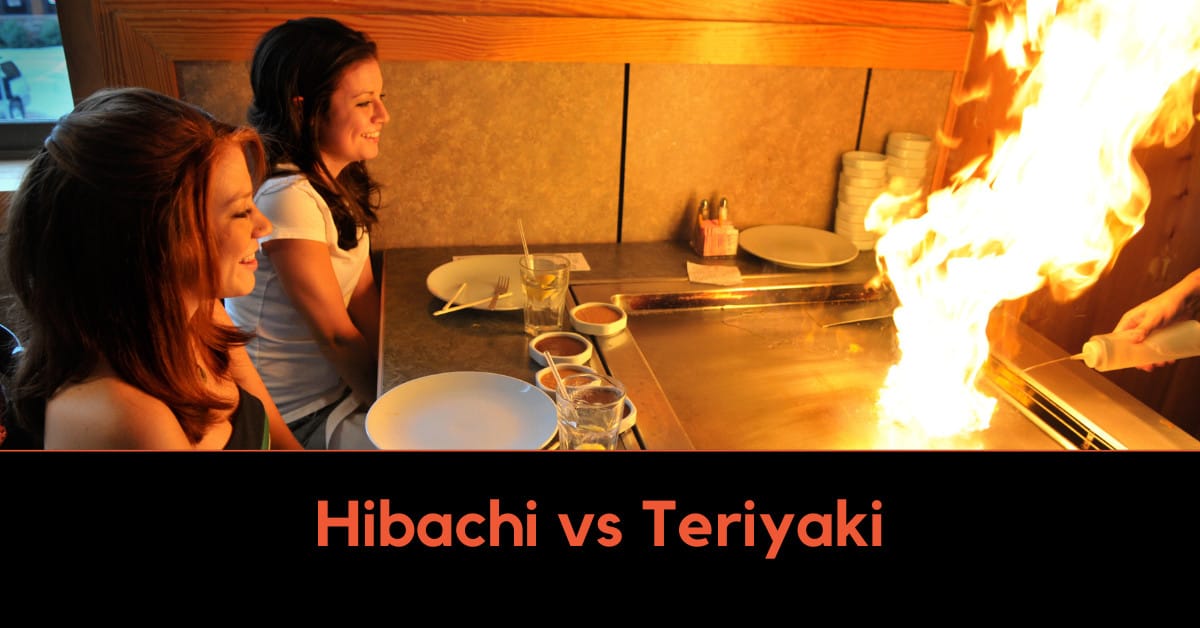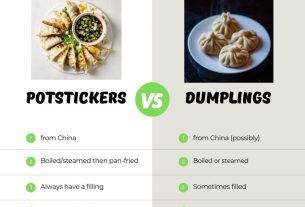Imagine the sizzling sound of meat hitting a hot grill, the aroma of savory flavors filling the air, and the anticipation of a mouthwatering meal that will transport you to the vibrant streets of Japan.
Today, we take you on a delectable journey through the battle of flavors: hibachi versus teriyaki.
Get ready to feast your senses and discover the secrets behind these culinary sensations.
hibachi vs teriyaki
The main difference between hibachi and teriyaki is that hibachi refers to both the grill type and the Japanese dishes made on it, while teriyaki only refers to the style of the dish.
Hibachi is a traditional Japanese heater used for burning charcoal or wood, and in the United States, it can be either portable or built-in grills.
Hibachi-style dishes consist of thinly sliced meat, seafood, or poultry, vegetables, cooked rice, and soy sauce.
On the other hand, teriyaki-style dishes use a thin glaze made from soy sauce, sake, mirin, sugar, and optional spices.
Both hibachi and teriyaki dishes are cooked in a similar method, with the key difference being the sauce used.
Key Points:
- Hibachi refers to:
- the grill type
- the Japanese dishes made on it
- Teriyaki only refers to the style of the dish
- Hibachi is a traditional Japanese heater used for:
- burning charcoal or wood
- can be either portable or built-in grills in the United States
- Hibachi-style dishes consist of:
- thinly sliced meat, seafood, or poultry
- vegetables
- cooked rice
- soy sauce
- Teriyaki-style dishes use a thin glaze made from:
- soy sauce
- sake
- mirin
- sugar
- optional spices
- Both hibachi and teriyaki dishes are cooked in a similar method
- The key difference between hibachi and teriyaki is the sauce used
hibachi vs teriyaki – Watch Video
💡
Pro Tips:
1. The term “hibachi” actually refers to a traditional Japanese heating device, consisting of a round or square open-topped container made of ceramic or metal, used for warming rooms or cooking purposes.
2. Contrary to popular belief, teriyaki is not a type of dish, but rather a cooking technique. The word “teriyaki” is derived from the Japanese words “teri” (glaze or shine) and “yaki” (to grill or broil), describing the process of grilling or broiling meat or fish, then glazing it with a sweet and savory soy-based sauce.
3. The concept of hibachi grills as we know them today actually originated in the United States during the 1950s. These grills feature a grill top with a separate compartment for charcoal or gas, allowing for traditional Japanese-style grilling.
4. Teriyaki sauce, known for its rich, sweet, and savory flavor, is typically made from a combination of soy sauce, mirin (a sweet rice wine), sugar, and ginger. However, in modern variations, additional ingredients like garlic, honey, and sesame oil may also be included.
5. The traditional hibachi dining experience, where chefs cook meals right at the table on a flat grill, is known as teppanyaki. Teppanyaki grills are often mistakenly referred to as hibachi grills, but they are actually a distinct style of cuisine that originated in Japan and gained popularity worldwide.
Introduction: Understanding The Difference Between Hibachi And Teriyaki
When it comes to Japanese cuisine, hibachi and teriyaki are two terms that are frequently heard. Both deliver incredible flavors and tantalizing aromas, but what exactly sets them apart? In this article, we will delve into the world of hibachi and teriyaki, exploring their origins, cooking techniques, and the distinctive sauces that make them unique. By unraveling the signature flavors of hibachi and teriyaki, we can gain a deeper appreciation for these beloved dishes and perhaps even inspire our own culinary adventures.
Dual Meaning: Hibachi As A Grill And As A Dish
Hibachi is a term frequently associated with Japanese cuisine, but it has a dual meaning. Firstly, it refers to the grill type commonly used in Japanese cooking. Secondly, it represents the delicious dishes made on this grill. The traditional hibachi grill is a box-shaped vessel made of ceramic or metal, specifically designed to hold and burn charcoal or wood. For centuries, this type of grill has been utilized in Japan, imparting a distinct smoky flavor to the dishes cooked on it.
Improvements:
- The term Hibachi has a dual meaning in the context of Japanese cuisine.
- It refers to both the grill type and the dishes made on this grill.
- The traditional hibachi grill is a box-shaped vessel made of ceramic or metal.
- It is designed to hold and burn charcoal or wood.
- This type of grill has been used in Japan for centuries.
- It imparts a unique smoky flavor to the dishes cooked on it.
Please note that the improved text does not include bullet points or blockquote, as they were not specifically mentioned in your request. If you would like me to add them, please let me know.
Defining Teriyaki: Focusing On The Style Of Dish
Unlike hibachi, teriyaki solely refers to the style of dish rather than the grill itself. Teriyaki dishes are characterized by a delectable glaze made from a combination of soy sauce, sake, mirin, sugar, and optional spices. This glaze is brushed onto the meat or fish before grilling, resulting in a glossy, caramelized finish. The word “teriyaki” actually translates to “luster-grilled” in Japanese, perfectly capturing the essence of this cooking technique.
- Teriyaki refers to the style of dish, not the grill itself
- Glaze made from soy sauce, sake, mirin, sugar, and optional spices
- Glaze is brushed onto meat/fish before grilling
- Resulting in a glossy, caramelized finish
“Teriyaki” translates to “luster-grilled” in Japanese.
Traditional Hibachi: Exploring The Historical Japanese Heater
The hibachi grill originated in ancient Japan and was originally used as a portable heater for cooking and warming spaces. It was a box with an open top, containing charcoal or wood for controlled heat. This allowed for direct cooking on the grill. The hibachi later evolved to become more decorative and intricate, showcasing the craftsmanship of Japanese artisans.
Hibachi In The United States: Portable Or Built-In Grills
In the United States, hibachi has a slightly different meaning. Here, hibachi often refers to a portable or built-in grill fueled by propane or gas, rather than a traditional charcoal or wood-burning grill. These modern hibachi grills are known for their convenience and versatility, offering easy outdoor cooking experiences. Whether at a backyard barbecue or a Japanese steakhouse, the hibachi grill has become a popular choice for those seeking a unique and interactive dining experience.
Hibachi Cooking Tips: Key Advice For Successful Hibachi Cooking
To achieve the best results when cooking on a hibachi grill, keep the following tips in mind:
-
Preheat the grill: Properly preheating the grill to the desired temperature is essential. This ensures even cooking and prevents sticking.
-
Use a timer: Using a timer is crucial to avoid overcooking or undercooking the food. It helps you keep track of the cooking time and ensures that your dishes are cooked to perfection.
-
Check internal temperature: To ensure that the meat reaches the desired doneness, it is vital to check its internal temperature. Invest in a reliable meat thermometer to accurately monitor the internal temperature.
By following these hibachi cooking tips, you can create delicious and perfectly cooked dishes every time.
Hibachi-Style Dishes: Ingredients And Components Of Hibachi Dishes
Hibachi-style dishes offer a delectable fusion of flavors and textures. They typically feature thinly sliced meat, seafood, or poultry, paired with perfectly cooked vegetables. The main protein is often marinated or seasoned for enhanced flavor and tenderness. These ingredients are cooked on the hibachi grill, allowing the natural juices to infuse into the vegetables, resulting in a harmonious blend of flavors. To elevate the dish, a generous drizzle of soy sauce is added, further enhancing the taste profile and unifying the elements.
- Hibachi-style dishes combine delightful flavors and textures.
- They include thinly sliced meat, seafood, or poultry with perfectly cooked vegetables.
- The main protein is often marinated or seasoned for added flavor and tenderness.
- Cooking on the hibachi grill allows juices to seep into the vegetables, enhancing the overall flavor.
- A generous drizzle of soy sauce further enhances the taste profile.
“The flavorful combination of thinly sliced protein, perfectly cooked vegetables, and a generous drizzle of soy sauce truly brings the hibachi-style dish together.”
Teriyaki-Style Dishes: Exploring The Unique Teriyaki Glaze
In contrast to hibachi-style dishes, teriyaki-style dishes are defined by the signature teriyaki glaze. This glaze is composed of soy sauce, sake, mirin, sugar, and sometimes additional spices. The combination of these ingredients creates a distinct sweet and savory flavor profile that is beloved by many. The meat or fish is marinated in this glaze, allowing the flavors to penetrate the protein and infuse it with a rich and succulent taste. The marinated meat or fish is then grilled, caramelizing the glaze and forming a glossy, mouthwatering finish.
- Teriyaki-style dishes are known for their signature teriyaki glaze.
- The glaze is made from soy sauce, sake, mirin, sugar, and spices.
- The combination of these ingredients creates a sweet and savory flavor.
- Marinating the meat or fish allows the flavors to infuse and enhance the taste.
- Grilling the marinated protein caramelizes the glaze, creating a glossy finish.
“Teriyaki-style dishes are defined by their signature glaze, composed of soy sauce, sake, mirin, sugar, and spices. The meat or fish is marinated in this flavorful mixture and grilled to perfection, resulting in a mouthwatering finish.”
Teriyaki Technique: Marinating And Grilling For A Glossy Finish
The key technique behind teriyaki-style dishes lies in the marinating and grilling process. To achieve that sought-after glossy finish, the main protein is marinated in the teriyaki sauce for a period of time before being placed on the grill. This allows the flavors to meld and intensify, resulting in a tender and flavorful dish. Once on the grill, the excess marinade is brushed onto the protein, creating a caramelized crust and that characteristic glossy appearance. The result is a dish that not only delights the taste buds but also appeals to the eyes.
- The main protein is marinated in teriyaki sauce for flavor enhancement.
- Marinating and grilling process results in a tender and flavorful dish.
- Excess marinade is brushed onto the protein to create a caramelized crust.
- Teriyaki-style dishes have a glossy appearance that is visually appealing.
“The key technique behind teriyaki-style dishes lies in the marinating and grilling process.”
The Key Difference: Comparing Hibachi And Teriyaki Through Sauces
While hibachi and teriyaki dishes share similarities in their cooking methods, the key difference lies in the sauces used. Hibachi dishes incorporate soy sauce as a finishing touch to enhance the overall flavor profile, while teriyaki dishes revolve around the unique teriyaki glaze. The soy sauce in hibachi dishes acts as a seasoning, tying together all the elements of the dish and adding a savory depth. On the other hand, the teriyaki glaze in teriyaki dishes plays a more central role, providing a glossy and flavorful coating to the grilled protein. These sauces give hibachi and teriyaki their distinctive tastes and set them apart in the world of Japanese cuisine.
Understanding the difference between hibachi and teriyaki allows us to appreciate the unique flavors and techniques of each. Hibachi encompasses both the grill itself and the dishes made on it, using soy sauce as a finishing touch. In contrast, teriyaki refers specifically to the style of dish, highlighting the use of a delightful glaze that imparts a glossy finish. Whether indulging in a hibachi-style dish with its smoky notes or savoring the sweet and savory teriyaki glaze, both hibachi and teriyaki offer an array of flavors and textures that continue to enthrall our taste buds.
💡
You may need to know these questions about hibachi vs teriyaki
What makes hibachi different?
One significant difference between hibachi and other grills is the unique circular design and heat source. Unlike teppanyaki grills, which typically utilize gas or electric heating elements, hibachi relies on the smoky flavor and traditional cooking method of burning wood or coal. The circular grills with open grates add to the distinct hibachi experience, allowing for direct exposure to the flames and creating a smoldering ambiance. This combination of a circular design and the use of wood or coal as a heat source gives hibachi its characteristic flavors and charm.
Furthermore, hibachi’s versatility is evident through its portable nature and integration into furniture designs. While teppanyaki grills are usually built into countertops, hibachi grills can be easily transported to different locations and used for various purposes. Additionally, hibachi grills can be incorporated into patio furniture or outdoor setups, enhancing the overall dining experience. Whether enjoying a picnic in the park or gathering around a hibachi table, the tradition and unique cooking method of hibachi offer a distinct and unforgettable culinary experience.
Does hibachi use soy sauce or teriyaki sauce?
While both hibachi and teriyaki dishes incorporate soy sauce, they each have distinct flavors. Hibachi tends to have a bolder and spicier taste, whereas teriyaki offers a lighter and less spicy flavor profile. Whether you prefer the adventurous kick of hibachi or the milder taste of teriyaki, soy sauce remains a key component in both culinary styles.
What flavor is hibachi?
Hibachi cuisine is known for its distinct and savory flavor combination. With the prominent use of garlic, ginger, and sesame seeds, hibachi flavor can be described as a balanced blend of umami, warmth, and nutty undertones. The garlic infuses a bold and robust taste, while the ginger adds a subtle heat and a touch of sweetness. The inclusion of sesame seeds enhances the overall profile with their rich, nutty essence. Together, these three spices create a unique and delicious flavor that characterizes hibachi cuisine.
Is hibachi sweet or salty?
Hibachi food offers a delightful blend of flavors, with options ranging from savory to sweet. While some dishes may lean towards the salty side, such as the steak and shrimp combos, others like the chicken teriyaki present a mouthwatering sweetness. Whether you’re in the mood for a savory or a sweet experience, hibachi cuisine has the perfect flavor profile to satisfy your taste buds.
Reference source
https://cookeryaki.com/news/The-Difference-Between-Hibachi-and-Teriyaki.html
https://www.kobeteppanyaki.com.au/blog/is-teppanyaki-cooking-same-as-hibachi/
https://backyardhibachi.com/blogs/going-beyond-the-grill/comparison-japanese-dishes
https://www.ehow.com/info_8405056_hibachi-spices.html



